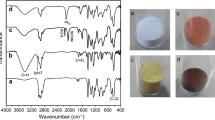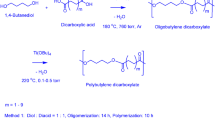Abstract
This paper follows up investigations in the field of solution properties of poly(vinyl alcohol). Here we present a combined investigation based on both theoretical and various experimental methods focused on peculiarities in hydrogen bond reorganization in aqueous poly(vinyl alcohol) solutions discussed as a function of temperature. It was demonstrated that the specific polymeric effect takes place in binary poly(vinyl alcohol)/water systems. The effect is characterized by the delay in response of the polymer system on heating until the critical temperature is reached. It was demonstrated in this paper that hydrogen bond reorganization in binary aqueous systems may lead to an increase in the degree of undesirable intermolecular cross-linking reaction. This finding was in contrast to previously made proposition based on hydrogen bond reorganization in ternary poly(vinyl alcohol) solutions. This assumption based on the theoretical studies was confirmed experimentally. Thus, a series of poly(vinyl butyral) samples were synthesized in various solvents using traditional catalysts (HCl) as well as the modern thermosensitive polymeric catalyst. It was demonstrated by using GPC and viscometry experiments that poly(vinyl butyral) samples with a low degree of acetalization (<10%) prepared in water in the absence of co-solvent additives are characterized by large molecular weights and bimodal molecular weight distribution. On the contrary, polymers prepared in mixed (ternary) systems and in the presence of a thermosensitive polymeric catalyst demonstrate relatively narrow molecular weight distribution. This indicates the preparation of more homogeneous products which also facilitates mechanisms of hydrogen bond reorganizations observed in binary and ternary poly(vinyl alcohol) solutions.









Similar content being viewed by others
References
Iwata H, Ikada Y (1979) Kinetic study on the inter- and Intramolecular Acetalization reactions of polymeric reactants. Macromolecules 12(2):287–292. https://doi.org/10.1021/ma60068a025
Gebben B, van den Berg HWA, Bargeman D, Smolders CA (1985) Intramolecular crosslinking of poly(vinyl alcohol). Polymer 26(11):1737–1740. https://doi.org/10.1016/0032-3861(85)90295-2
Zhao D, Liao G, Gao G, Liu F (2006) Influences of Intramolecular cyclization on structure and cross-linking reaction processes of PVA hydrogels. Macromolecules 39(3):1160–1164. https://doi.org/10.1021/ma052419l
Rumyantsev M (2013) Influences of co-solvent on hydrogen bond reorganization in ternary poly(vinyl alcohol) solutions. Eur Polym J 49(8):2257–2266. https://doi.org/10.1016/j.eurpolymj.2013.05.005
Ferry J (1980) (1980) viscoelastic properties of polymers3rd edn. Wiley, New York
Rumyantsev M, Zelentsov SV, Gushchin AV (2013) Retardation effect in acetalization of poly(vinyl alcohol) with butyraldehyde. Eur Polym J 49(6):1698–1706. https://doi.org/10.1016/j.eurpolymj.2013.03.014
Wu CS Handbook of size exclusion chromatography and related techniques, CRC press 2003
Rumyantsev M, Rumyantsev S (2018) Combining advantages of homogeneous organocatalysis and heterogeneous catalysis with thermosensitive single-chain nanoparticles in a representative tetrahydropyranilation of alcohols. Polymer 136:101–108. https://doi.org/10.1016/j.polymer.2017.12.058
Rumyantsev MS, Gushchin AV, Zelentsov SV (2012) Effect of the type of hydrogen bonding on the reactivity of hydroxyl groups in the acetalization of poly(vinyl alcohol) with butanal. Polymer Science Series B 54(9):464–471. https://doi.org/10.1134/s1560090412090047
Yeh I-C, Wallqvist A (2009) Structure and dynamics of end-to-end loop formation of the Penta-peptide Cys-Ala-Gly-Gln-Trp in implicit solvents. J Phys Chem B 113(36):12382–12390. https://doi.org/10.1021/jp904064z
Tesei G, Paradossi G, Chiessi E (2012) Poly(vinyl alcohol) oligomer in dilute aqueous solution: a comparative molecular dynamics simulation study. J Phys Chem B 116(33):10008–10019. https://doi.org/10.1021/jp305296p
Wu C (2010) Cooperative behavior of poly(vinyl alcohol) and water as revealed by molecular dynamics simulations. Polymer 51(19):4452–4460. https://doi.org/10.1016/j.polymer.2010.07.019
Kaur H, Sasidhar YU (2012) For the sequence YKGQ, the turn and extended conformational forms are separated by small barriers and the turn propensity persists even at high temperatures: implications for protein folding. J Phys Chem B 116(12):3850–3860. https://doi.org/10.1021/jp210227s
Allen MP (1987) DJT computer simulation of liquids. Oxford University Press, New York
Pal S, Kundu TK (2012) Theoretical study of hydrogen bond formation in Trimethylene glycol-water complex. ISRN Physical Chemistry 2012:12. https://doi.org/10.5402/2012/570394
Fileti EE, Chaudhuri P, Canuto S (2004) Relative strength of hydrogen bond interaction in alcohol–water complexes. Chem Phys Lett 400(4):494–499. https://doi.org/10.1016/j.cplett.2004.10.149
Tamai Y, Tanaka H, Nakanishi K (1996) Molecular dynamics study of polymer−water interaction in hydrogels. 1. Hydrogen-bond structure. Macromolecules 29(21):6750–6760. https://doi.org/10.1021/ma951635z
Tager A (1978) Physical chemistry of polymers, 2nd English edition; Mir publisher: Moscow
Hu Y, Gamble V, Painter PC, Coleman MM (2002) Functional group accessibility in hydrogen-bonded polymer blends. 4. Cross-linking effects. Macromolecules 35(4):1289–1298. https://doi.org/10.1021/ma011793s
Acknowledgements
Experimental work including thermosensitive polymeric catalyst preparation was financially supported by the Russian Science Foundation project №17-73-10206; LD simulations were financially supported by The Ministry of Education and Science of the Russian Federation (a project part of the state task in the field of scientific activity, №10.2326.2017/PP).
Author information
Authors and Affiliations
Corresponding author
Additional information
Publisher’s note
Springer Nature remains neutral with regard to jurisdictional claims in published maps and institutional affiliations.
Rights and permissions
About this article
Cite this article
Rumyantsev, M., Rumyantsev, S., Kazantsev, O.A. et al. Managing of hydrogen bonding in aqueous poly(vinyl alcohol) solutions: new perspectives towards preparation of more homogeneous poly(vinyl butyral). J Polym Res 27, 52 (2020). https://doi.org/10.1007/s10965-020-2031-y
Received:
Accepted:
Published:
DOI: https://doi.org/10.1007/s10965-020-2031-y




